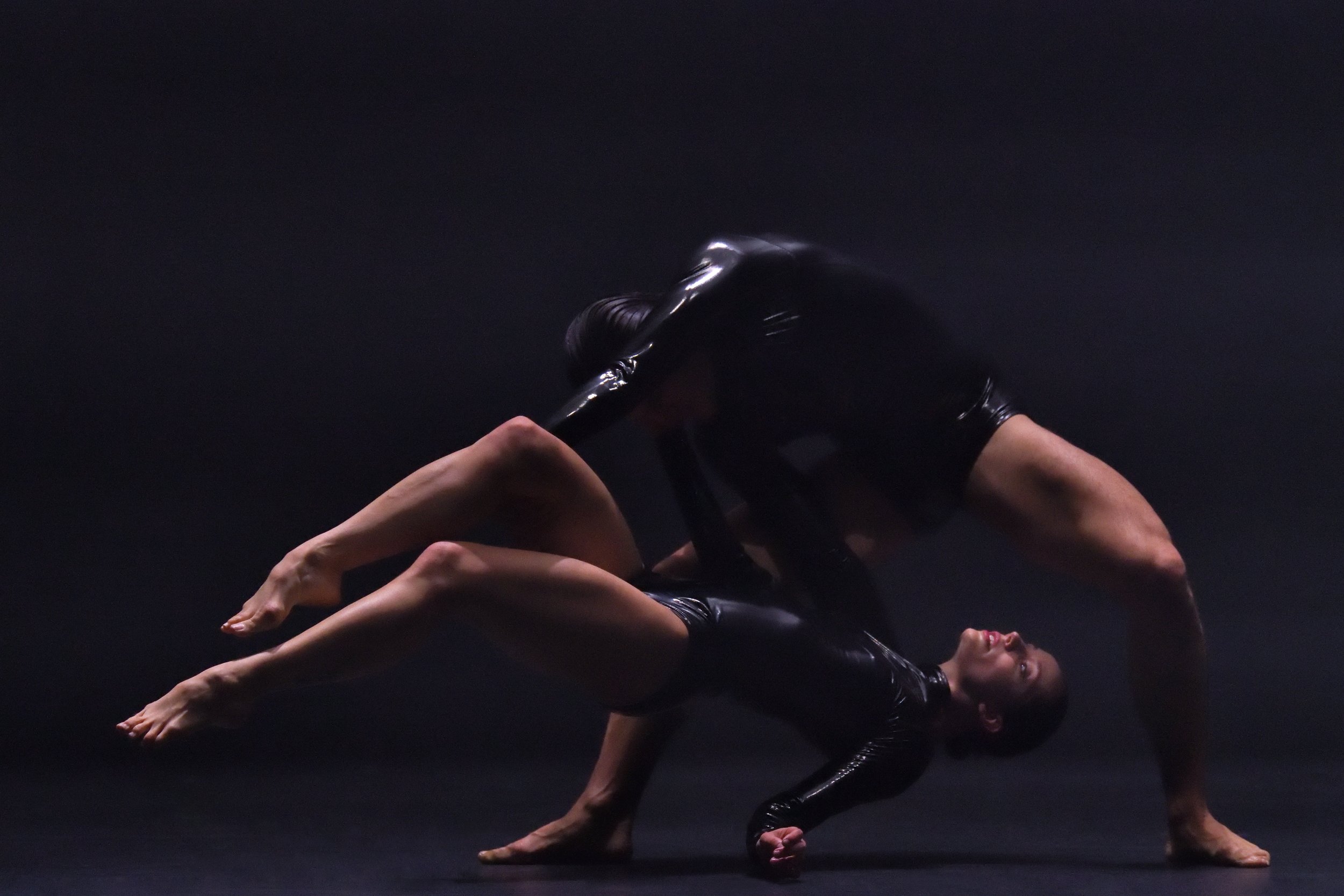Dance review: Throbbing beats, surging sexuality, and time stands still at Ballet BC's edgy OVERTURE/S season opener
Buzzy show wires directly into the European contemporary-dance vanguard
Ballet BC Dancers Sarah Pippin and Rae Srivastava pull off a slo-motion roll in Silent Tides. Photo by Michael Slobodian
Ballet BC’s OVERTURE/S continues to November 5 at the Queen Elizabeth Theatre
A PACKED QUEEN E. THEATRE, Euro dance stars, eye-poppingly chic designer clothes, and flowing Merlot: Ballet BC’s season-opening OVERTURE/S had a buzz about it that hasn’t been seen since before you-know-what.
Signifying new beginnings, the evening saw the introduction of incoming managing director Kim Spencer-Nairn, (with a formal farewell to John Clark, who helped pull the organization successfully through the pandemic).
In the crowded lobby, Finnish dance star Tero Saarinen rubbed shoulders with Ballet BC’s Paris-born artistic director Medhi Walerski and young Dutch choreographic duo Marne and Imre van Opstal (who were in town for the Ballet BC premiere of their edgy Heart Drive, a coproduction with Saarinen’s company).
The triple bill onstage lived up to the anticipation, while also pushing boldly toward the cutting edge—think black PVC, pulsing beats, and hypnotic bars of fluorescent light. Sexuality surged through each of the three, rigorously carved pieces, and the company—starting the season with new young talents from around the world—looked thrillingly energized.
Sharon Eyal and Gai Behar’s throbbing Bedroom Folk, on its first live return here since its debut in 2019, set a fitting tone. Setting its huddle of 12 black-clad dancers against a glowing orange-red background, it has never looked more like a strange and hallucinogenic nightclub rite. The group jerks, squats, and shuffles to DJ Ori Lichtik’s relentless beats, bodies occasionally breaking free of the replicant-like horde—including, at one point, magnetic, platinum-haired newcomer Michael Garcia arching and slinking out like some elongated cat. Batsheva Dance Company alumna Eyal’s ability to build startling imagery with bodies always amazes—whether it’s arms blasting up like pistons from out of a tight, machinelike unit of bodies, or women’s fingers splaying above the crouched men’s heads like spiky crests.
Michael Garcia leaps out from the crowd in Ballet BC’s Bedroom Folk. Photo by Michael Slobodian
Up next was the North American premiere of Walerski’s own Silent Tides, a silky pas de deux in which the choreographer stretches out and plays with time in the most sophisticated of ways. Half-nude, in white pants, dancers Sarah Pippin and Rae Srivastava are riveting. A hypnotic bar of fluorescent light moves up and down across the stage behind them, marking the minutes—expanding and accelerating time, and sometimes pausing in gorgeous suspended limbo. As Adrien Cronet’s electroacoustic score gives way to a Johann Sebastian Bach violin concerto, the partnering makes sculptural angles out of bent elbows and knees, with unusual inverting, twisting lifts; at one point, Pippin makes a languorous, slo-mo roll across Srivastava’s back, her legs extended in splits.
The lighting creates some haunting moments: at one point, each dancer hovers still in the black void behind their moving partner, a barely visible ghost. (Tom Visser served as consultant to designers Pierre Pontvianne and Lisette van der Linden on the look.) Just as the piece reaches for the infinite, there are endless meanings to the duet—profound messages about love, mortality, and the eternal tides of life. Time really does stand still.
The van Opstals’ Heart Drive is the most overt exploration of sexuality, the choreographers investigating our inner, animal forces in noncliched and open-minded ways.
The piece is an experiment in juxtapositions. The dancers, dressed in shiny, fetishwear-like black body suits, move amid a stark geometric world—Dutch lighting genius Tom Visser slicing up the stage with triangular beams, giving the work a hard edge. The effect seems to suggest the eternal boxing-in and suppression of our desires—creating a constant need for release. Instead of an equally hard electro accompaniment, the score has a more human, organic feel thanks to Amos Ben-Tai’s raw acoustic sounds.
Dancers move ferally, often on all fours, gyrating their hips, lunging low to the floor; they slip through each other’s open legs and pull each other hungrily. The van Opstals’ movement language is distinct and a bit surreal, full of distorted bends, ever-flexed feet, and broken-doll disruptions. The partnering is an innovative highlight, with spectacular, sultry work from Kiana Jung with Michael Garcia, Pippin with Srivastava, and guest artist Chloé Albaret with emerging artist Orlando Harbutt. Men pull the women over their heads, legs opening into erotic open Vs; one turns his partner, straight upside down with her head on the floor, like a slow drill.
Dreamlike imagery, as Ballet BC Dancer Orlando Harbutt partners with guest artist Chloe Albaret in Heart Drive. Photo by Michael Slobodian
Haunting and dreamlike, feeling a bit like Bosch by way of The Matrix, Heart Drive is a strange and alluring taste of the European vanguard. The crowd on opening night was up for the challenge, giving it a loud standing O.
The key here is that—as much as Ballet BC will draw on local talent this season (Radical System Art’s Shay Kuebler is creating a work for the company in the new year)—the company is wiring directly into what’s happening right now in Europe. In a preshow chat, the affable van Opstal siblings, alumni of Nederlands Dans Theater, marvelled that Ballet BC is one of the only North American contemporary-dance companies hooking up with European choreographic talent at the moment. Those connections go both ways, of course: on opening night, Walerski also announced the troupe will tour his home country, France, in January. So, yeah, there’s a reason for the Ballet BC buzz right now.















